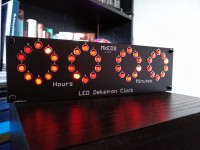Dekatron inspired clock.

40 LEDs. Some 1960s inspiration. And a dash of style.
I have designed a retro look clock which displays the time using four "wheels" of LEDs arranged in groups of ten. Each LED therefore represents a value from zero to nine, with the wheels indicating from left to right, Hours tens, Hours units, Minutes tens and Minutes units. As each wheel has more digits than needed for a time display (apart from the Minute units) the display is animated each second by sequentially lighting each LED across the display before settling and displaying the current time again. A “twinkle” effect can be activated. This gives a simulated, flickering “afterglow” to all the display elements. This lends the clock a wonderful, retro look.
Optionally, at 27 seconds, for five seconds, the date and month are displayed, with no animation during this five seconds, to differentiate between the time and date displays. The clock was inspired by the old Dekatrons I saw on the WITCH computer at the Museum Of Computing (based at - but separate to - Bletchley Park) in 2019. These, if you are not old enough to remember, are cold cathode (Valve or Tube) counting devices which when pulsed in the correct sequence move a neon glow forwards or backwards around a circular display which can then be read electronically as well as visually.
I was really pleased with this clock. It was one of those rare designs, that ended up looking and working exactly as I had originally imagined it. The black PCBs and the orange LEDs also give it that 1960s look I was aiming for.
The software was written inGreat Cow Basic and the source code is included.
Optionally, at 27 seconds, for five seconds, the date and month are displayed, with no animation during this five seconds, to differentiate between the time and date displays. The clock was inspired by the old Dekatrons I saw on the WITCH computer at the Museum Of Computing (based at - but separate to - Bletchley Park) in 2019. These, if you are not old enough to remember, are cold cathode (Valve or Tube) counting devices which when pulsed in the correct sequence move a neon glow forwards or backwards around a circular display which can then be read electronically as well as visually.
I was really pleased with this clock. It was one of those rare designs, that ended up looking and working exactly as I had originally imagined it. The black PCBs and the orange LEDs also give it that 1960s look I was aiming for.
The software was written inGreat Cow Basic and the source code is included.



Discussion (0 commentaire(s))